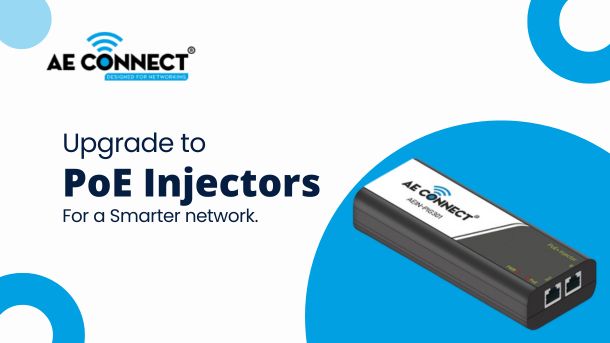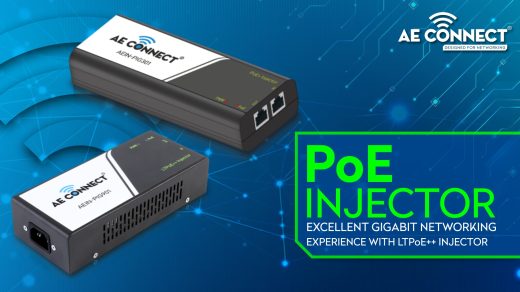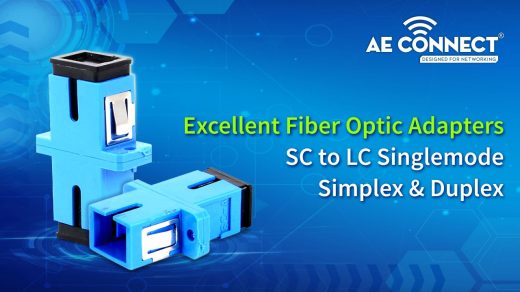A PoE injector can be really helpful for setting up cables, but you might have some questions about it. So, what exactly is a PoE injectors, and how do you use it? Well, you can use a PoE injector to power devices like IP cameras through an Ethernet cable. But which PoE injectors is the best for you? Don’t worry, we’ll answer all these questions. And if you ever need help, just reach out to the AE Connect team.
What Is a PoE Injector?
Utilizing PoE (Power over Ethernet) devices such as PoE switches, PoE media converters, and PoE injectors simplifies the process of transmitting both power and data simultaneously through Ethernet cables. Imagine setting up devices in spots without nearby power outlets—a power injector comes to the rescue! They convert regular AC power from a wall socket into a special DC power signal that works perfectly with PoE standards. It’s like giving your devices a power boost through the Ethernet cables themselves!
How Does a PoE Injector Work?
PoE injectors is basically like a power booster for Ethernet cables, which allows devices like IP cameras, VoIP phones, and access points to get both data and power through just one cable.
Here’s how it works:
- Power Source: Power is obtained by the injector through either a wall outlet or an adapter.
- Power Conversion: It turns this power into a type that devices can use, usually between 48V and 57V.
- Power Input: The injector itself is powered by a direct cable connection.
- Device Detection: It talks to the device over the cable to figure out how much power it needs.
- Data and Power Together: It sends both power and data through the same cable.
- Device Power-Up: The device gets power from the injector and can then do its job on the network.
This setup keeps things simple and tidy, reducing the need for extra cables and power outlets.
Key features of PoE injector
PoE injectors are like power boosters for Ethernet cables, making it simple to power devices like cameras and phones over the same cable used for data. Here are some key features that make the power injector handy:
1. Plug-and-Play Setup
You can easily get started with a PoE injectors without any complicated setup or special software. They’re designed for convenience.
2. Compatibility with Different Devices
Most injectors can power a wide range of devices that follow standards like IEEE 802.3af, 802.3at, and 802.3bt, ensuring their good cooperation.
3. Adjustable Power Levels
Depending on the model and standard, the PoE injectors can provide different amounts of power, ranging from 44W to 150W. This flexibility lets you match the power to what your device needs.
4. Safety First
PoE injector include safety features such as protection against short circuits and overvoltage, ensuring the power they deliver is safe and dependable.
5. Protection Against Surges
With surge protection of up to +/- 2kV, PoE injectors are great for both indoor and outdoor setups, keeping your devices safe from sudden electrical surges.
Types of PoE injectors
The PoE injector comes in different types, each with its own way of sending power through Ethernet cables to devices. Knowing these types can help you pick the right one for what you need.
1. Active PoE injector
Active Poe injectors are sophisticated devices that actively communicate with PoE-enabled devices to determine their power needs. They negotiate and deliver the exact amount of power required by the device, optimizing power usage and efficiency. This dynamic power delivery ensures that devices receive sufficient power without wasting energy.
Active PoE injectors are particularly beneficial for scenarios where precise power control is essential, such as in high-power devices like PTZ cameras or feature-rich access points. Although they may be slightly more expensive due to their advanced power management capabilities, their effectiveness justifies the investment in situations that demand accurate power management.
2. Passive PoE injector
Passive PoE injectors deliver a fixed amount of power to PoE-enabled devices without negotiating power requirements. They provide a simpler and more cost-effective solution compared to active injectors. However, because they deliver a set amount of power regardless of the device’s actual needs, they may not be as efficient in power utilization. Passive Poe injectors are commonly used in simpler setups where precise power control is not critical, such as in basic IP cameras or VoIP phones.
3. Midspan PoE injector
A Midspan injector, also known as PoE midspan or PoE++ injector, is a device placed between a non-PoE network switch and PoE-enabled devices. It adds PoE capability to existing networks without needing a PoE-enabled switch. This is great for updating older systems to support PoE devices without changing the whole network setup.
4. Endspan PoE injector
Endspan PoE injectors, or integrated PoE switches, do double duty by combining a network switch and PoE injectors in one device. They’re perfect for new setups needing PoE support right away. Endspan injectors make things simpler by integrating PoE++ injector directly into the switch, reducing the need for extra equipment and making installations cleaner.
How to Use a PoE Injector?
Using a PoE injector is easy. Start by connecting one end of an Ethernet cable to the injector’s “Data In” or “LAN In” port and the other end to your network switch or router. Then, plug the injector into a power source using its AC adapter.
Next, connect another Ethernet cable from the injector’s “Data and Power Out” or “LAN Out” port to your PoE-enabled device, like an IP camera or access point. The injector will automatically figure out how much power your device needs and send both power and data through the cables, powering up your device without needing extra power cords.
Conclusion
PoE injectors are valuable tools that improve network connectivity by transmitting power and data through Ethernet cables simultaneously. They simplify installations, reduce clutter, and offer flexibility in network setups. With compatibility across various PoE standards, they power devices like IP cameras, access points, and VoIP phones reliably. Whether upgrading existing networks with midspan injectors or setting up new installations with endspan injectors, PoE injectors plays a crucial role in modernizing and optimizing network infrastructures. Do visit us at https://aeconnect.co.in/ for any queries related to the PoE injector.
FAQs
Q1. What devices can I power using PoE injectors?
You can power a wide range of devices, including IP cameras, access points, VoIP phones, and other 30 watt PoE injector devices that comply with IEEE standards like 802.3af, 802.3at, and 802.3bt.
Q2. Can I use a 30 watt poe injector with a non-PoE switch?
Yes, you can use a 30 watt PoE injectors with a non-PoE switch by connecting the injector between the switch and the PoE-enabled devices. This allows you to add PoE capability to an existing network without replacing the switch.
Q3. What safety features do 90 watt poe injector have?
90 watt PoE injectors typically includes safety features such as short-circuit protection, over-voltage protection, and surge protection (up to +/- 2kV). These features ensure safe and reliable power delivery to PoE-enabled devices, protecting them from electrical damage.




